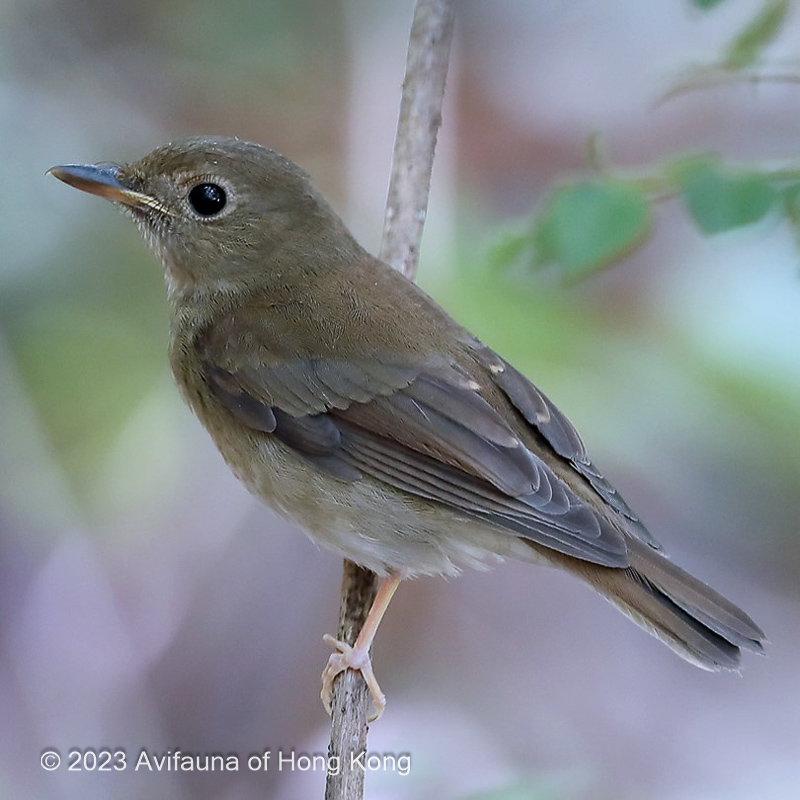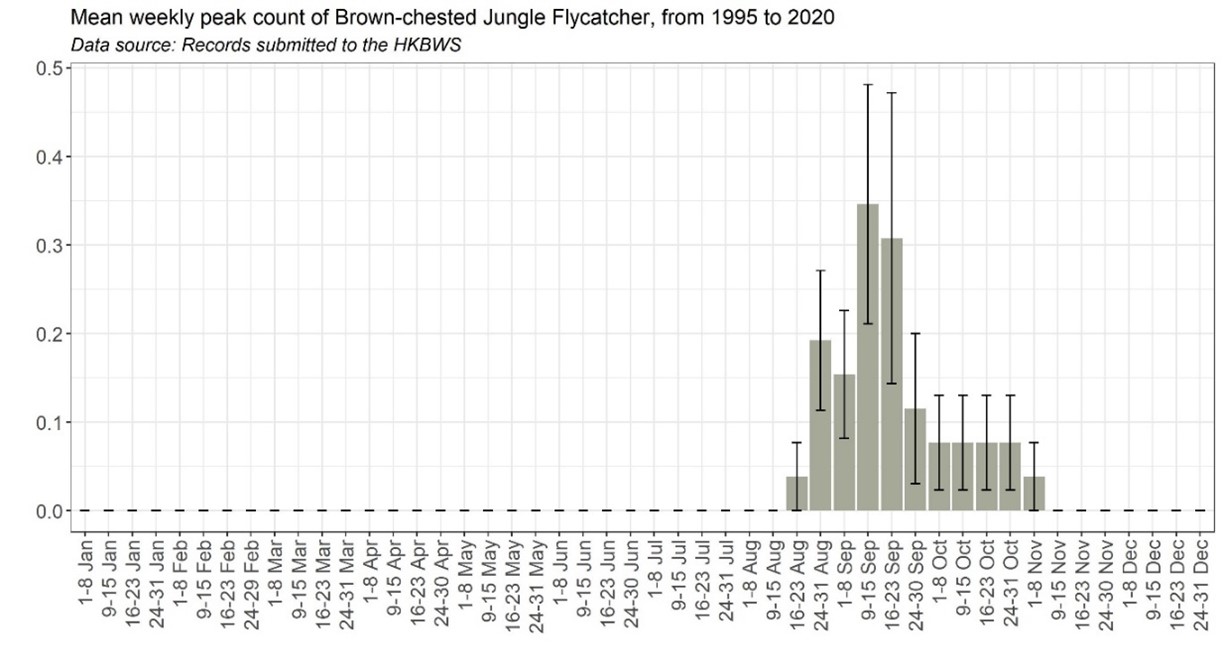Brown-chested Jungle Flycatcher Cyornis brunneatus 白喉林鶲
Category I. Scarce autumn migrant.
IDENTIFICATION

Oct. 2017, Michelle and Peter Wong.
13-15 cm. A medium-sized, plump brownish flycatcher with a long, heavy bill and prominent pale buff eye ring and lores. Sexes alike. Plain brown head and mantle, the rump, uppertail coverts and tail are rufous-brown. Breast and flanks are pale brown, with the centre of the breast sometimes appearing scaly; the rest of the underparts are white. Dark upper mandible and yellowish lower mandible. Legs pink. First-winter birds are similar to adults but show a dark tip to the lower mandible and buff tips to the tertials.
VOCALISATIONS
Not a vocal species away from the breeding grounds. Calls include a short, modulated rattle with the individual elements well-spaced out.
Also, a harsh rattle.
The song is distinctive and consists of two short two-phrases, the first lower-pitched than the second.
DISTRIBUTION & HABITAT PREFERENCE
Occurs in wooded areas with plenty of shade. Of the 36 birds recorded up to 2020, 13 were at Tai Po Kau and 13 were at the migrant site of Ho Man Tin. Eight of the Tai Po Kau birds were caught in mist-nets under a ringing scheme and would otherwise have gone undetected. At Ho Man Tin, where there are limited areas of vegetation, it has been recorded annually since 2014.
OCCURRENCE
Scarce autumn migrant from 22 August to 4 November. The highest count is four trapped at Tai Po Kau on 18 September 2015.
First recorded at Kap Lung during 16-21 September 1995 (Hopkin et al. 1996), there were no further records until two in 2004. Thereafter, it was recorded in six autumns from 2005 to 2014, but there were no more than two birds in total per annum. It has been annual since 2013 with up to eight birds each year. The total number of wild individuals recorded in HK is 36. There have also been three winter records of birds regarded as ex-captive.
Figure 1 shows that peak numbers occur from the last week of August to the third week of September; 67% of all records occurred during this period.
BEHAVIOUR, FORAGING & DIET
A shy species that favours shaded areas in woodland. Can appear sluggish, often sitting motionless on a branch for a minute or more. It is invariably seen singly and can often be seen near ground-level.
In typical flycatcher fashion, it makes aerial sallies from a perch for flying insects. Unlike most flycatchers, however, it may also hop on the ground for food, and on occasions forages low in the undergrowth. It has been seen to take fruit and larvae from leaf litter (Hopkin et al. 1996).
SYSTEMATICS & RANGE
Monotypic. A restricted-range species that breeds only in southeast China in primary forest and mature secondary growth up to 1600m in south Henan, south Anhui and Zhejiang south to Guangxi, Guangdong and Fujian. It winters in the Malay Peninsula and probably Sumatra. On passage, it is recorded in Shanghai, Hainan, Yunnan, Vietnam and south Thailand (Clement and Christie 2020).
CONSERVATION STATUS
IUCN: VULNERABLE. Population small and decreasing due to destruction of lowland forest in its breeding and wintering grounds, primarily through logging for timber and conversion to agricultural production.
Figure 1.

Clement, P. and D. A. Christie (2020). Brown-chested Jungle-Flycatcher (Cyornis brunneatus), version 1.0. In Birds of the World (J. del Hoyo, A. Elliott, J. Sargatal, D. A. Christie, and E. de Juana, Editors). Cornell Lab of Ornithology, Ithaca, NY, USA. https://doi.org/10.2173/bow.bncjuf1.01
Hopkin, P. J., M. Hale, R. W. Lewthwaite and P. J. Leader (1996). Brown-chested Flycatcher: the first record for Hong Kong. Hong Kong Bird Report 1995: 123 – 128.

